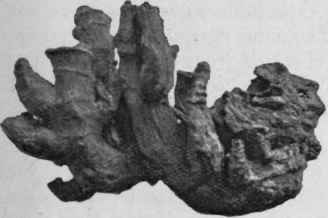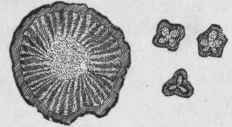Cimicifuga (Rhizoma Cimicifugae, Radix Actaeae Racemosae, Black Snakeroot)
Description
This section is from the book "A Text Book Of Materia Medica, Being An Account Of The More Important Crude Drugs Of Vegetable And Animal Origin", by Henry G. Greenish. Also available from Amazon: A Text Book of Materia Medica : Being an Account of the More Important Crude Drugs of Vegetable and Animal Origin.
Cimicifuga (Rhizoma Cimicifugae, Radix Actaeae Racemosae, Black Snakeroot)
Source, Etc
Cimicifuga racemosa, Elliot (Aetoea racemosa, Linne), is a tall herbaceous plant belonging to the natural order Ranunculaceoe.
It grows freely in shaded woods in Canada and the United States, extending southwards as far as Florida. In the autumn after the plant has fruited and the leaves have died down, the stout, perennial rhizome is collected, cut into pieces, and dried. It was introduced into medical practice in the United States about 1823, and in this country about 1860.
Description
The drug consists of a thick, hard, and knotty horizontal rhizome with numerous stout ascending branches. The rhizome averages about 5 to 8 cm. in length and 1 cm. in diameter, but may attain as much as twice these dimensions; the commercial drug consists, however, usually of pieces 2 to 5 cm. long. The branches, which are so close together as almost to conceal the rhizome, are about 1 cm. thick and 3 cm. or more long; they curve upwards, and terminate either in the remains of a bud or more frequently in a circular cup-shaped scar exhibiting a distinctly radiate structure. Both the rhizome and its branches bear encircling scars of cataphyllary leaves, those on the branches being more conspicuous.

Fig. 149. - Black Snakeroot, showing branches curving upwards and marked with leaf-scars. Natural size.

Fig. 150. - Black Snake-root. Transverse section through a branch of the rhizome, and through roots. Natural size. (Maisch).
From the under surface of the rhizome numerous straight stout roots are given off. These are dark brown in colour and obscurely quadrangular or longitudinally furrowed; they are rather brittle, and are usually broken off near the rhizome. The interior of the drug is hard and horny. The transverse section of the rhizome exhibits a thin dark horny bark surrounding a ring of numerous paler narrow wedges of wood alternating with wide dark medullary rays; the centre is occupied by a large dark pith. The branches have a similar structure.
The transverse section of the root frequently exhibits a thick bark and four (or sometimes five or six) distinct wedges of porous whitish wood, arranged in the form of a Maltese cross, the medullary rays being broad and dark; this characteristic structure is usually best seen in the stoutest roots.
The drug has no marked odour, but a bitter acrid taste. The student should observe
(a) The numerous stout branches curving upwards,
(b) The structure of the rhizome, and of the root, exhibited by the transverse section; and should compare the drug with
Black hellebore rhizome, which is tortuous and provided with irregular branches not exhibiting a prominent curve upwards; the section of the rhizome exhibits a thicker bark and few wood-bundles; in that of the roots the wood is much less distinctly cruciate.
Constituents
The drug contains three crystalline substances, iso-ferulic (hesperetic) acid, sugar, tannin, phytosterol, etc.; it yields about 7 per cent, of ash. The crystalline substances have not yet been sufficiently investigated. The name racemosin has been applied to a crystalline bitter principle obtained from the drug. The term cimicifugin, macrotin, or macrotyn is applied to a mixture of resinous substances obtained by pouring a concentrated alcoholic tincture into water
Uses
Cimicifuga influences the gastric secretion, like any other bitter, and, to a slight extent, depresses the rate but increases the force of the pulse. It has been used as a stomachic in diseases of the heart, but is more frequently employed as a remedy for rheumatism, neuralgia, dysmenorrhea, dyspepsia, etc. Its value is questionable.
Continue to:


